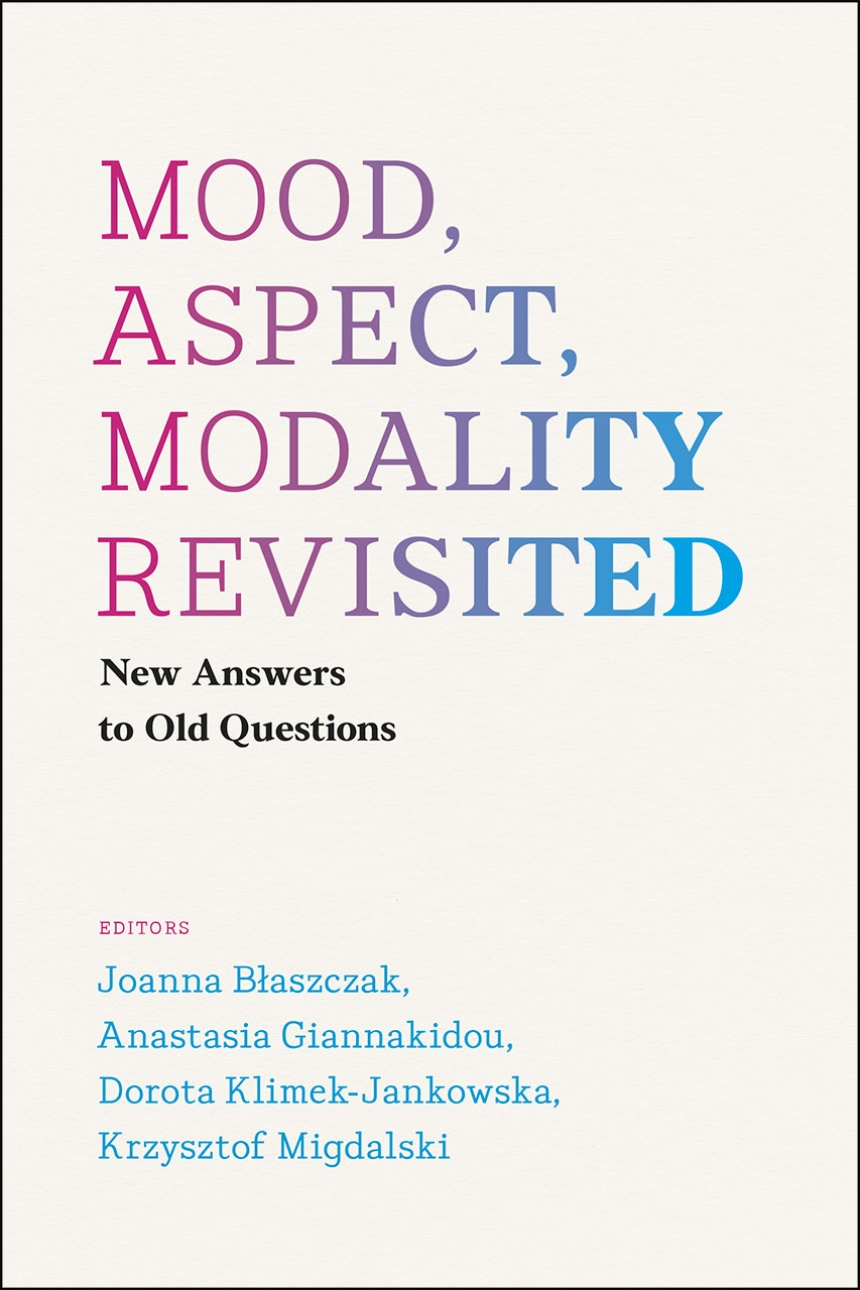Mood, Aspect, Modality Revisited
New Answers to Old Questions
Over the past several decades, linguistic theorizing of tense, aspect, and mood (TAM), along with a strongly growing body of crosslinguistic studies, has revealed complexity in the data that challenges traditional distinctions and treatments of these categories. Mood, Aspect, Modality Revisited argues that it’s time to revisit our conventional assumptions and reconsider our foundational questions: What exactly is a linguistic category? What kinds of categories do labels such as “subjunctive,” “imperative,” “future,” and “modality” truly refer to? In short, how categorical are categories?
Current literature assumes a straightforward link between grammatical category and semantic function, and descriptions of well-studied languages have cultivated a sense of predictability in patterns over time. As the editors and contributors of Mood, Aspect, Modality Revisited prove, however, this predictability and stability vanish in the study of lesser-known patterns and languages. The ten provocative essays gathered here present fascinating cutting-edge research demonstrating that the traditional grammatical distinctions are ultimately fluid—and perhaps even illusory. Developing groundbreaking and highly original theories, the contributors in this volume seek to unravel more general, fundamental principles of TAM that can help us better understand the nature of linguistic representations.
Current literature assumes a straightforward link between grammatical category and semantic function, and descriptions of well-studied languages have cultivated a sense of predictability in patterns over time. As the editors and contributors of Mood, Aspect, Modality Revisited prove, however, this predictability and stability vanish in the study of lesser-known patterns and languages. The ten provocative essays gathered here present fascinating cutting-edge research demonstrating that the traditional grammatical distinctions are ultimately fluid—and perhaps even illusory. Developing groundbreaking and highly original theories, the contributors in this volume seek to unravel more general, fundamental principles of TAM that can help us better understand the nature of linguistic representations.
400 pages | 17 halftones, 15 line drawings, 14 tables | 6 x 9 | © 2016
Language and Linguistics: General Language and Linguistics, Phonology and Phonetics, Syntax and Semantics
Reviews
Table of Contents
Preface
PART I. Tense, Aspect, and Modals: Their Categorial Status and Cross- linguistic Variation
Chapter 1. TAM Coding and Temporal Interpretation in West African Languages
Anne Mucha and Malte Zimmermann
Chapter 2. Modals: Meaning Categories?
Valentine Hacquard
Chapter 3. Epistemic Future and Epistemic MUST: Nonveridicality, Evidence, and Partial Knowledge
Anastasia Giannakidou and Alda Mari
PART II. Irrealis Moods: Subjunctive and Imperative
Chapter 4. On Finiteness and the Left Periphery: Focusing on Subjunctive
Manuela Ambar
Chapter 5. Evaluative Subjunctive and Nonveridicality
Anastasia Giannakidou
Chapter 6. The Essence of a Category: Lessons from the Subjunctive
Martina Wiltschko
Chapter 7. Imperatives as (Non-)modals
Mark Jary and Mikhail Kissine
Chapter 8. Approaching the Morphosyntax and Semantics of Mood
Ilse Zimmermann
PART III. Aspectual Recursion and Aspectual Coercion
Chapter 9. Aspectual Composition and Recursion
Henriëtte de Swart
Chapter 10. Can Semantic Theories Be Tested Experimentally? The Case of Aspectual Coercion
Oliver Bott
Chapter 11. Aspectual Coercion versus Blocking: Experimental Evidence from an ERP Study of Polish Converbs
Joanna Błaszczak and Dorota Klimek- Jankowska
About the Editors
About the Contributors
Index
PART I. Tense, Aspect, and Modals: Their Categorial Status and Cross- linguistic Variation
Chapter 1. TAM Coding and Temporal Interpretation in West African Languages
Anne Mucha and Malte Zimmermann
Chapter 2. Modals: Meaning Categories?
Valentine Hacquard
Chapter 3. Epistemic Future and Epistemic MUST: Nonveridicality, Evidence, and Partial Knowledge
Anastasia Giannakidou and Alda Mari
PART II. Irrealis Moods: Subjunctive and Imperative
Chapter 4. On Finiteness and the Left Periphery: Focusing on Subjunctive
Manuela Ambar
Chapter 5. Evaluative Subjunctive and Nonveridicality
Anastasia Giannakidou
Chapter 6. The Essence of a Category: Lessons from the Subjunctive
Martina Wiltschko
Chapter 7. Imperatives as (Non-)modals
Mark Jary and Mikhail Kissine
Chapter 8. Approaching the Morphosyntax and Semantics of Mood
Ilse Zimmermann
PART III. Aspectual Recursion and Aspectual Coercion
Chapter 9. Aspectual Composition and Recursion
Henriëtte de Swart
Chapter 10. Can Semantic Theories Be Tested Experimentally? The Case of Aspectual Coercion
Oliver Bott
Chapter 11. Aspectual Coercion versus Blocking: Experimental Evidence from an ERP Study of Polish Converbs
Joanna Błaszczak and Dorota Klimek- Jankowska
About the Editors
About the Contributors
Index
